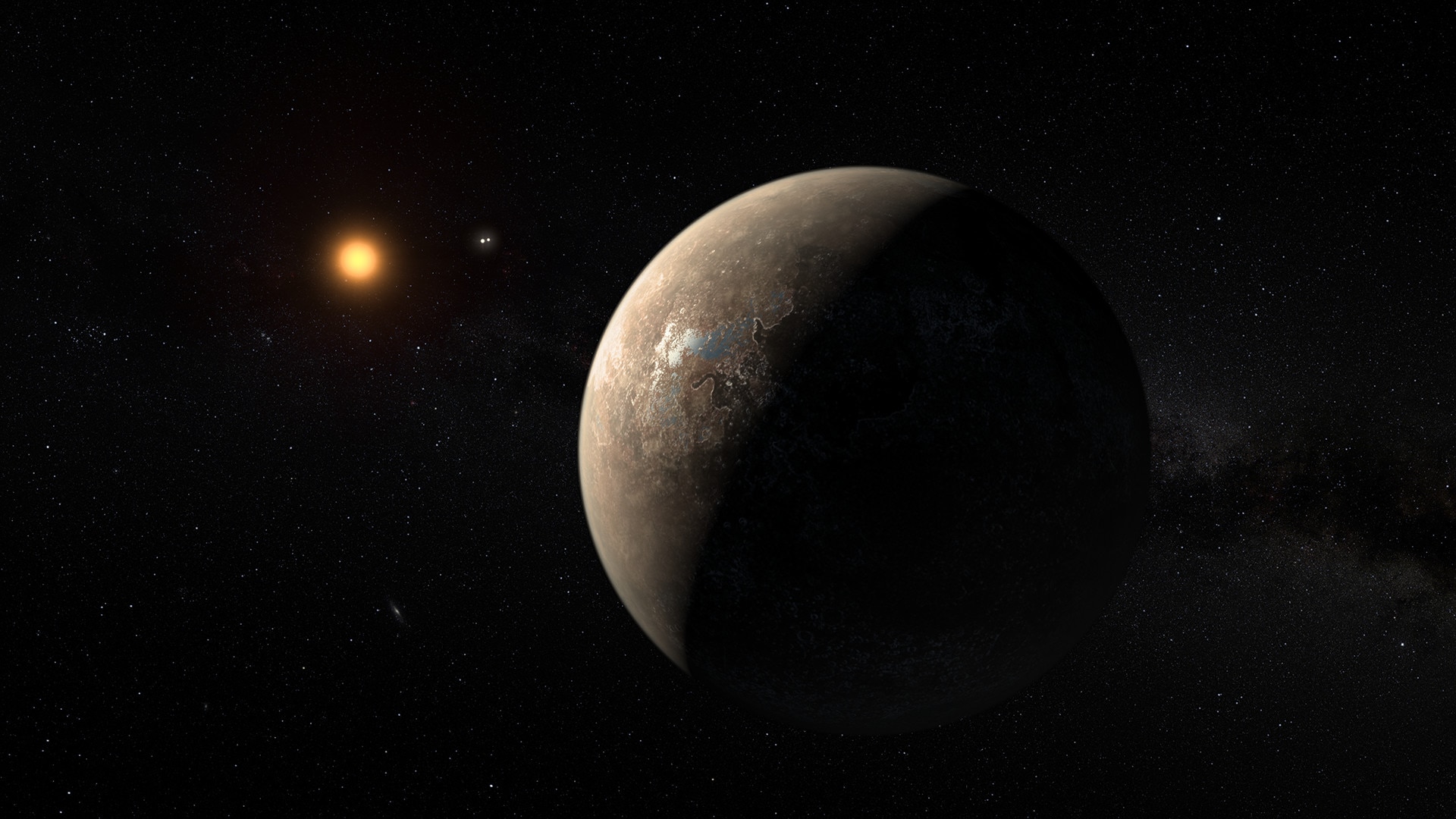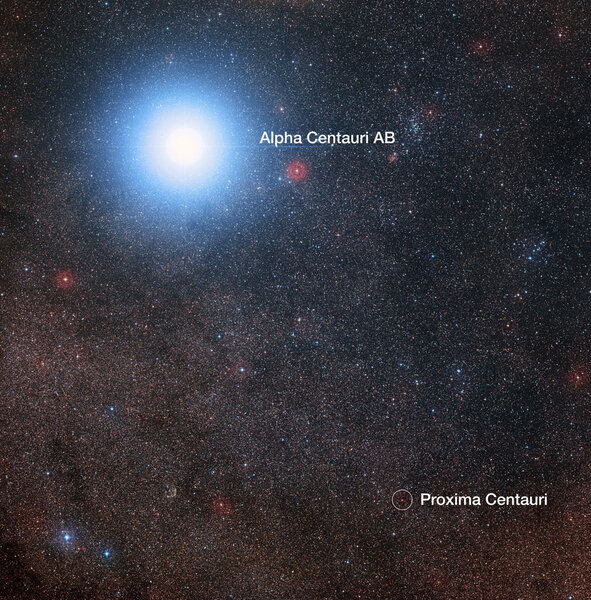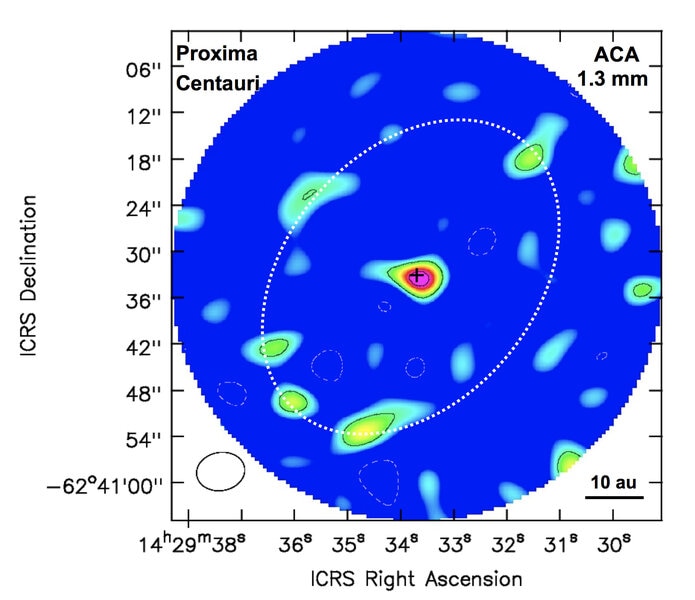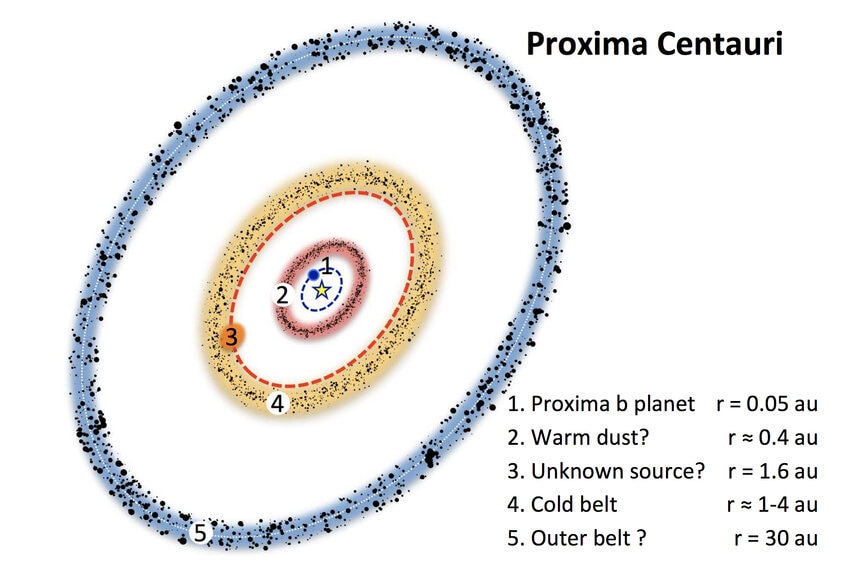Create a free profile to get unlimited access to exclusive videos, sweepstakes, and more!
What mysteries lurk at Proxima Centauri?

Despite being only 4.3 light-years away from Earth, the trio of stars comprising Alpha Centauri still holds a lot of mysteries. It being the closest star system to us, you'd think we'd have teased out most of its secrets by now, but in fact we're still learning basic stuff about it.
We know some of the basics, of course. The system has two stars that orbit each other in a binary, one of which (called Alpha Centauri A) is much like the Sun and the other (Alpha Cen B) is a tad smaller and cooler. Nearby is a third star, Proxima Centauri, a low-mass and cool red dwarf, that by happenstance is somewhat closer to us, on the near side of the system.
But after that, things get a bit hazy. For example, it was only in 2017 that astronomers showed conclusively that Proxima, the smallest of the three stars, was physically a part of the system at all. Until then all the evidence, though convincing, was circumstantial, but observations taken over many years showed that Proxima orbits around the other two stars — what we call a hierarchical triple star system.
In 2012 it was announced that a planet had been found orbiting Alpha Centauri A, making it the closest known exoplanet to our solar system. However, in 2016, serious doubt was cast on that discovery, and most astronomers now think that planet doesn't exist (to be fair, there might be a planet or planets orbiting Alpha Cen A, but that specific claim turns out to have been spurious).
In that same year, though, astronomers announced a planet detected orbiting Proxima, and that one has stood the test of time. Proxima Centauri b, or just Proxima b for short, is a planet with at least 1.3 times as much mass as Earth, and orbits Proxima once every 11.2 days. That means it's very close to the star, about 7 million kilometers out, but Proxima is such a dim bulb that the planet gets about the same amount of heat we do from the Sun. We don't know much else about it, but just knowing it exists is a big deal.
Astronomers have been looking at Proxima pretty intensely for many years now, with a lot of different equipment. And finally, after all this time, we're starting to learn more about it. The problem is, the evidence is still tantalizingly vague.
Late last year, an interesting paper came out: Astronomers used the ALMA telescope to take a peek at Proxima. ALMA is sensitive to light that has a far longer wavelength than light we humans see, the sort of light emitted by cold dust in space.
And that's just what they found around Proxima! Their data indicate there is a ring of dust circling the star, between roughly 150 and 600 million kilometers out (so well outside the orbit of the known exoplanet). The dust is cold, about 40K (about -230°C or -390° F). Using a little bit of physics, they find that the total amount of dust adds up to roughly four millionths of the Earth's mass, which isn't very much. But that's just the mass in dust. As far as we know, the source of dust like this is collisions between asteroids. Looking at the physics of that, they estimate the total mass in the ring of dust and bigger objects may be as high as 1% of Earth … roughly the mass of our Moon. Mind you, it's likely to be in the form of lots of little rocks up to a few dozen kilometers across, and not something big like the Moon.
But, given the temperature and total mass, this looks a lot like our own solar system's Kuiper Belt: a vast region beyond Neptune loaded with rocky iceballs. A belt of debris like that may be the natural outcome of planetary formation, so it makes sense we might see something like this at Proxima.
But there's more. Even farther out, more like 500 billion kilometers away, they detected a series of clumpy stuff that form a rough ellipse around the star. It looks very much like a circular ring seen at an angle of about 45°, but the detection isn't strong enough to stake a definitive claim. But it's intriguing: It looks like another ring of dust, though this time much colder, around 10 K (-260° C or -220°F). Doing the same math, there's something like 0.0004 times the Earth's mass in dust in it, or about 1/3 our mass in solid objects. That's substantial. It's a bit hard to explain why it's there, though, and they note we need better and deeper observations to confirm or disprove its existence.
But it's intriguing. If that 45° angle is the orbital plane of the Proxima system, then it means the true mass of the known planet Proxima b is actually about 1.8 times the mass of the Earth (the mass we calculate for it depends on the angle we see it orbiting at, and that can be difficult or impossible to know). That makes it decently more massive than Earth, and that may in turn mean its composition and atmosphere (assuming it has any air) are very different.
So these observations have some interesting implications. Hopefully we'll have more information soon!
The ALMA observations found another, even more intriguing thing. There is a blob of light very close to the star itself, about 240 million km out (so, well outside Proxima b's orbit). It's fainter than the star by quite a bit, but it could be another dusty ring … but one that isn't orbiting the star, but another, previously unknown planet. In other words, an exoplanet with rings! Mind you, the data are very iffy, but it would take a planet about the mass of Saturn to hold onto dust like that. So if this detection is real, and if it's dust, Proxima may have its own analog of Saturn!
That's cool. But again, we just don't know yet. Clearly, we have more observing to do.
One more thing: Another team of astronomers recently announced that in August 2016 they may have seen a dip in Proxima's light that lasted for about an hour, the kind of thing you'd expect if there's a planet orbiting the star close in, and as it orbited it came directly between Proxima and us, blocking its light. Their data are very, very marginal, and there are lots of things that can cause such a dip besides a planet (it could be noise in the data, or the star itself might have had a minor bit of stellar activity — like a solar flare — that artificially inflated the brightness baseline). It also seems unlikely a planet would orbit the star in a 2-4 day orbit and have been missed.
I'll note that there have also been claims of detections of Proxima b having transits, but the reality of those has recently been thrown into doubt.
My point? Observing Proxima is hard. Even though it's the closest known star to the Sun, it's so small and faint (you need a telescope to see it at all!) that trying to squeeze information from it is a tough thing to do.
So we still have a lot of questions that need answers. Are there more planets? Is Proxima b Earth-like or Neptune-like? What else can we find out about these dust rings, and what do they imply about the Proxima system?
Still, astronomers (while eager) are patient. We keep looking. And we build better equipment and dream up better methods of observations all the time. Soon we'll know a lot more about our closest neighbor.





























